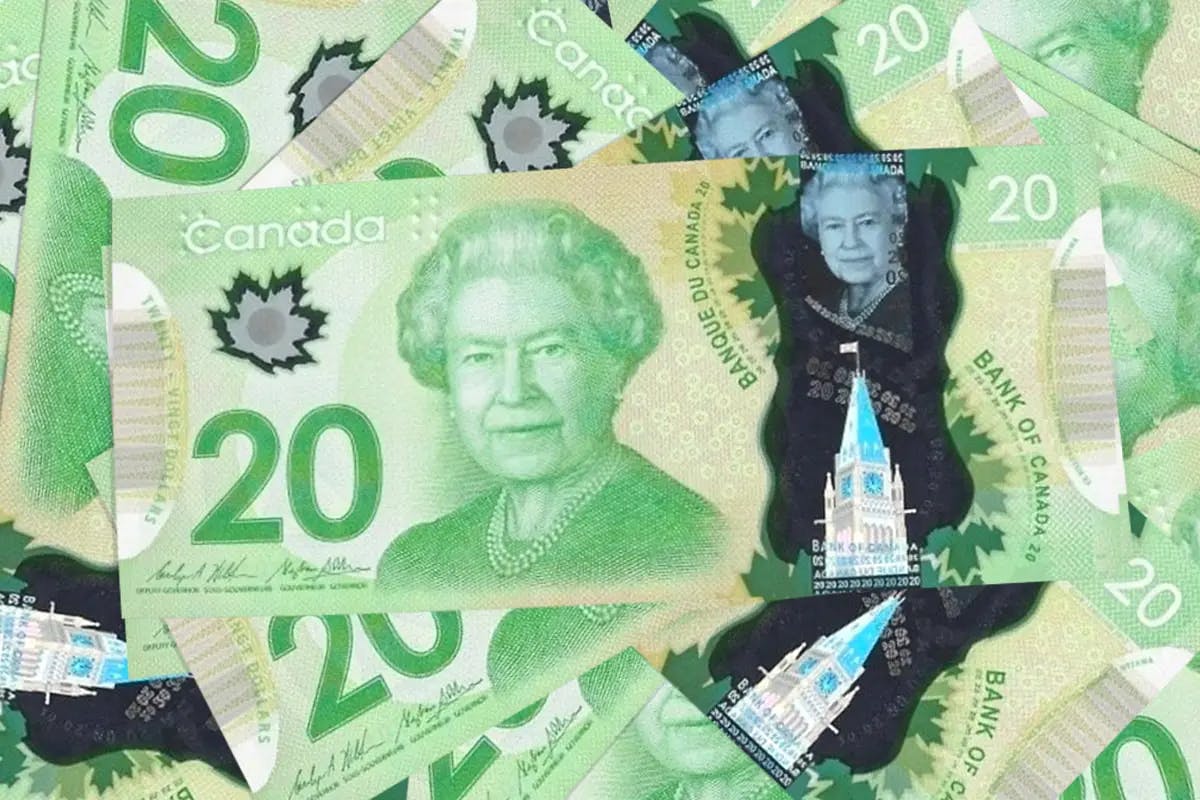5 Things You Might Not Know About the Canadian 20 Dollar Bill
By JC Pittman | Published on 08 Sep 2022

It is trivia time for the 20 dollar bill. This banknote has all the plot points of a dramatic television. We have nudity, bankers, royalty, ambition, war, and of course, scandal.
1: The 20 dollar bill wins the 2004 “Banknote of the Year”
The Canadian 20 dollar bill released in 2004, the “Canadian Journey Series”, featured the most advanced currency security traits at the time. The bill features a portrait of Queen Elizabeth II on the front of the banknote. There is artwork inspired by the Haida culture on Canada’s Pacific coast on the reverse side.
The 2004 issue of the Canadian 20 dollar bill won the International Banknote Society’s 2004 Banknote of the Year. The Viola Desmond Canadian $10 won the same award in 2018.
The artwork on the reverse of the “Canadian Journey Series” is by Haida artist Bill Reid. Reid’s artwork features prominent characters that figure heavily in Haida oral traditions and cosmological worldview:
- The Raven and the First Men
- A Haida Grizzly Bear
- The Spirit of Haida Gwaii
- Mythic Messengers.
The Haida-inspired Canadian 20 dollar bill also features a bilingual passage from La Montagne Secrète by Gabriel Roy. The 2010 Haida Gwaii Reconciliation Act returned ownership of their islands to the Haida people. They renamed the colonial era Queen Charlotte Islands Haida Gwaii.
2: Paying with a demi in Quebec
A banknote represents a specific value of money exchageable for goods. Unless you have the exact amount, you’ll likely receive change. That means that the currency is divisible.
“Breaking a bill” for change was common when payphone and parking meters were commonplace. You always needed small amounts of change. But can you simply cut a bill in half and claim it is worth half of its stated value?
Residents in Quebec’s Gaspé region developed a micro-economy by creating their own “demi” bills. “Demi means “half” in French.
In 2016, residents and local businesses in the area began accepting Canadian 20 dollar bills cut in half. It represented half the banknote value.
Yes, in the Gaspé region, you could use half a Canadian 20 dollar bill to pay for coffee and donuts. Can you imagine putting them all back together with tape?
What do you do when you go to deposit them in your chequing account? Do you apologize?
3: People really see what they want, don’t they?
Perspectivism is a philosophical principle that boils down to this: what we perceive is subjective. Regardless of the location or the subject, people more often see and interpret what they want in any situation.
Canadians question the symbolism on the Canadian $20. Many Canadians did not understand the historical significance of the 2011-2013 “Frontier Series” Canadian $20.
The banknote features the Canadian National Vimy Memorial in Vimy, France. The monument honours the sacrifices of Canadians in the First World War. Poignantly, it lists the names of those who were killed and received no final resting place.
The Battle of Vimy Ridge was the first time that all four divisions of the Canadian Expeditionary Force fought side-by-side as Canadians. It became a national symbol of achievement and sacrifice. Canadians have used Vimy Ridge for decades to speak of national unity and pride.
About Vimy Ridge, a piece of Canada in the middle of Europe
When you step onto the 250-acre Canadian Memorial Monument park, you walk above wartime tunnels, craters, and unexploded munitions. When you enter this park, you are in Canada! France ceded the 250-acre park to Canada with the knowledge that this land would be used for a battlefield park and memorial.
The Vimy Ridge monument took eleven years to construct and sits on hill 145. The hill was critical to Canadian success during the battle. Hill 145, the battlefield’s highest altitude terrain and sitting at the top of the highest point in the region, is a Canadian symbol of peace.
Sadly, a 2012 Canadian focus group did not know about this critical moment in Canadian history or the monument commemorating it. Instead, the participants each interpreted the depiction on the bill differently.
It is not the Twin Towers
Some Canadians believed the image on the $20 was the World Trade Center in New York. This is despite the banknote clearly stating that the image is of the “Canadian National Vimy Memorial.”
The two towers on the Canadian $20 are filled with deep symbolism and meaning. The banknote depicts only a portion of the Vimy monument. There are two towers represent Canada and France, clearly leading to confusion.
A desire for peace
Some questioned why the banknote’s image should focus on war when the image “should be a symbol of some peace.” It does. The highest point of the Vimy Ridge monument features a character representing peace.
The overall intended message of the Vimy Ridge monument represents the defeat of militarism and a desire for peace.
The 20 dollar bill is not porn
Can a person find an allegorical character representing peace problematic? Of course!
Some Canadians focused on problems in the image’s finer details. They claim the Canadian 20 dollar bill to be “too pornographic”. It features a Greek-inspired monument.
On the contrary, the influences that sculptor Walter Seymore Allward used for the Vimy Ridge monument were primarily Italian. Plus the limestone was found in an old Roman quarry in Croatia.
The “pornographic” characters are known as “The Chorus,” representing truth, faith, justice, charity, knowledge, and peace. It features bare-breasted sculptures ascending the two towers at Vimy Ridge.
The imagery is inspired by Italian art, including Canada Bereft. It is a sculpture inspired by images of Mater Dolorosa and Michelangelo’s Pietà. Canada Bereft represents the young Mother of Canada mourning the loss of her young nation’s children.
Another type of invasion: frosted maple leaves
Even Canadian botanists took issue with the “Frontier Series” banknote. Botanists focused on the stylized “frosted” maple leaf on the banknote, insisting that the maple leaf on this generation of Canadian $20 is the Norwegian species of the plant, considered “invasive” and a “threat” to the Canadian maple species. The Bank of Canada insists this was not the intention nor the result of the maple leaf on the “Frontier Series” Canadian 20 dollar bill.
What you were meant to see on the 20 dollar bill
The Vimy Ridge memorial is not a tribute to the glory of war, and none of the symbolism used by Allward on the monument suggests that. The symbolism of the monument runs deeper than some Canadians’ incorrect understanding of what this war monument and the battle of Vimy Ridge means to Canadian history and national identity.
It is true, however, that the Vimy Ridge monument receives justified modern-day criticism for its lack of cohesion in the monument’s sprawling message.
In each of these instances, it is clear that Canadians across the country exhibited perspectivism and saw what they wanted in the imagery from the “Frontier Series” $20.
4: The only face on the Canadian 20 dollar bill (kind of…)
Portraits of two members of the Royal Family have graced the front of the Canadian $20: King George the VI and Queen Elizabeth II. Canadians nearing 100 years old have watched the Queen age from portrait to portrait on Canadian 20 dollar bills.
A portrait of 8-year-old Princess Elizabeth was featured on the 1935 “First Series” Canadian 20 dollar bill, along with a rose pink colour scheme and an allegory to toil on the banknote’s reverse.
Green for fertility
The future Queen and all royal family portraits were changed to a single portrait of King George the VI for 1937’s “Bilingual Series.” This series featured the first use of green as the Canadian 20 dollar bill’s dominant colour. It has an allegorical engraving representing fertility on the reverse.
Actually, it is the exact engraving that was on the reverse of the 1935 Canadian $500. Versions of King George VI’s Canadian 20 dollar bill are valued between $25 and $225.
Queen Elizabeth II and the green colour scheme returned to the Canadian $20 in 1954’s “Canadian Landscape Series.” Since 1954, Canadians have seen an ever-changing portrait of Queen Elizabeth II as the face of the bill.
By the way, the engraving of “The Laurentians in the winter” on the reverse of “Canadian Landscape Series” was based on a publicity photo from Quebec’s Provincial Publicity Bureau.
The “Frontiers Series” Canadian 20 dollar bill has two different versions in circulation: the standard design and a commemorative banknote dedicated to the historic reign of Queen Elizabeth II. This commemorative note marked Queen Elizabeth II’s surpassing 63 years and 216 days as monarch in 2015.
A few minor features on this commemorative Canadian 20 dollar bill make it different from every other banknote, the most important being that it features a youthful portrait of Queen Elizabeth II from 1951 in the upper right corner. This is the only portrait of Queen Elizabeth II wearing her crown on a Canadian banknote.
5: Issues with the “Scenes of Canada” series
If you have read any of my other articles on Canadian banknotes, you’ll know that the 1969-1979 “Scenes of Canada” series banknotes are my favourite Canadian banknote designs. The Bank of Canada used a slightly different shade of green on these bills to further differentiate the banknote from the Canadian 1 dollar bill.
An image of Moraine Lake in Alberta’s Valley of the Ten Peaks, based on an image from the Canadian Pacific Railway’s photo collection, was used on the bills. The original image was replaced in 1979 because it did not look natural on the engraving.
The firm responsible for the bills acquired pictures of the same scene of Moraine Lake and painstakingly recreated this image to suit the Canadian 20 dollar bill. Morain Lake is breathtaking on its own, yet, when you consider the work required to bring the lake scene to life on the Canadian $20, it makes the “Scenes of Canada” series more awe-inspiring.
